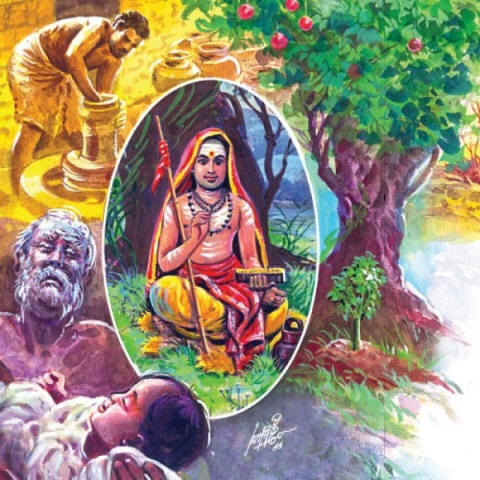Published:08 Apr 2019 8 PMUpdated:08 Apr 2019 8 PM Sakthi Vikatan
ஆதியும் அந்தமும் - புதிய தொடர்
(= Adhi & Andham = The beginning and the end - New Series)
சேஷாத்ரிநாத சாஸ்திரிகள்
Seshadrinatha Sastrikal (SNS)
மறை சொல்லும் மகிமைகள் = The Greatness of the Writings of Vedas...

.
1. Ādhi and Andham. Ādhi means the beginning; Andham means the end. A multitude of deeds we do in our lives. We make objects. We interact with others. There is a duality: beginning and end in all these. The objects we fashioned also have a beginning and an end. Do you know what Vedas and Sastras say? All created objects in this world have a beginning and an end.
2. A seed is our model for Ādhi. We sow the seed in the mud. As it rains, the seed germinates. What is in the seed that shows up as cotyledon. That is Ādhi; germination is change in morphology. It is also known as Pariṇāmam (transformation or modification). It does not stand still. It became a seedling or a sapling and a tree. As the tree grows, we see shoots, flowers, unripe fruits and then ripe fruits. At each stage of development, there is a transformation from the old to the new. The old dies as it were, and the new entity takes its place until all transformations come to an end. This beginning and the end are the unavoidable events in the lives of all living things.
3. All products have this beginning and the end: these are “Punarapi Jananam purnarpi maranam,” according to Ādhi Saṅkarar. The borns die. The dead will be reborn. Thus, this cycle of metempsychosis revolves.
4. The Tarkka cāstiram (treatise on debate) says ‘Shatbhāva Vihāra,’ meaning all living things are subject to six Avasthais (states).
5. Some entities defy the duality of beginning and end. No one knows the beginning of the Vedas. We have no idea of God. He is in a non-dual state.
6. God has no beginning and no end. He is all-pervasive. He is the Potter, working with clay. If the pot breaks, it assumes its original state of clay. Likewise, when the creation ends, the imperishable agent (God) remains eternal.
7. God is the causal agent for the creation of the fauna, flora, and other life forms and their demise.
8. God is sight-averse. Those who do not accept God call it Nature. No one knows his origin.
9. Nature is perishable, but God is not. God has not known beginning and end; likewise, this universe has no beginning and no end. This world, as part of the universe created by God, has beginning and end.
10. The beginningless and the endless Sakthi, also known as Parāśakti, is eternal. It has no form and is beyond any measure and formless. However, it is the causal agent of creation. That Sakthi is beyond physical perception with our eyes. We call that Sakthi, God. Any applied name will suit him. You may call him Bhagavan. You may call him Kadavul or Inner Abider. You can call him Nature.
11. What is our perception from all these attributes or lack thereof?
12. The sign of the Universe
The objects with the beginning and the end have in them the beginning. But the objects with undefined or unknown end are entities without beginning or end. We come across a multitude of objects like this in this world.
13. What is our primary need? We need the intellect to understand a multiplicity of various entities. We should share this knowledge. The mere theory is insufficient. The organ’s intrinsic function, its objective, the knowledge we gain from them, the knowledge we gain because of them, the good thoughts they generates within our mind, and the loftiness of the soul are all essential and relevant. The needed maturity and guideposts, the education, or the methods are available for us in this world in various modalities.
14. The sine qua non of the universe is its association with a multiplicity of objects. We can never perceive this universe as unitary. The animals, the birds, and the humans can never have one quality pervading them. Each is separate and unique. But, what all have in common is Sakthi, called Ātmā.
15. Knowing about that Sakthi is our Ātma Lābham (gain). We will know about it from the learned wisdom of others, the Religious or theological treatises, and referential sacred texts. We will study the books, their authors, their opinions, and research materials. By looking into these avenues of knowledge, we will know about the creator and the maintainer of the universe. The knowledge we gain from this will help advance our happiness and fulfillment in life.
16. An opportunity presents itself for the explication of matters of this kind.
17. Many religions took their forms based on theories. The adherents of these religions declare the supremacy of their religion and its tenets.
18. They lack a deeper understanding of the Tattva (Reality), the reason for creation, the imperishable objects in the universe, and the essential, indispensable, and related knowledge we should know. But our Sāstras present an elaborate account. Today’s need is to know them and impart to others of our learning
19. In pursuit, I will not indulge in telling you stories and amusing anecdotes but will delve into Truth and Reality as they are expounded in the Sastras and share them with you. They are a treasure trove that takes us to the very limit bordering on amazement.
Mahāmagōpāthyāya Seṣādrinātha Sāsthrigaḷ

1. A rich man realized the fast-approaching last days to cross the rubicon between life and afterlife. He thought of realizing the heavenly bliss as said by Jñāṉis before his demise. He told all his visitors about this and asked for their opinion.
2. They told him knowing heavenly bliss by hearsay from Jñāṉis, and reading about it, and nothing more than that. However, they never realized it themselves.
3. He met an ascetic. Learning of his desire, he sent him to a Jñāṉi in the nearby town. The rich man took his money and jewels in a bag and met the Jñāṉi. He dedicated his wealth at his feet and expressed his desire. Having looked at the aspirant intently for some time, he picked up the bag and ran.
4. “Ayō! He runs with my riches. Catch him. He is no Jñāṉi, but a thief,” he shouted.
5. Some ran after the thief but could not catch him. They returned to the hermitage after a tiresome run.
6. Lo and behold! The valuable bag was still in place. The Jñāṉi stood by the bag as before. They were happy to see him. The Jñāṉi, laughing, said, “The heavenly joy is the manyfold experience compared to the happiness (சிற்றின்பம்) you get on recovering what you lost.”
7. He said, “All of you lost the center of your Āṉmā. Search and find it. Then you will feel the heavenly bliss (பேரின்பம்).”